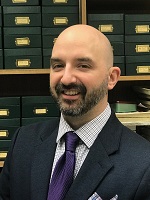Differentiating the Undifferentiated: An Immunohistochemical Approach
Immunohistochemistry (IHC) is an indispensable complement to a morphology- and epidemiology-driven approach to tumor diagnosis. This lecture will focus principally on an immunohistochemical approach to the tumor of uncertain lineage, with a nod to the important allied carcinoma of unknown primary differential. There will be a brief review of a few technical aspects of IHC, which lead to imperfect interchangeability of IHC assays between laboratories. The focus will be on the use of screening marker IHC, site of anatomic presentation, and morphologic pattern to assign broad tumor class (i.e., “the big 4 plus 3 more”). Several specific instances will be discussed in which markers assumed to be specific for one broad tumor class are expressed by other classes. An initial screening panel for the small round blue cell tumor differential will be presented, followed by additional diagnostic considerations/useful markers if the initial panel is noninformative, and a discussion of the utility of S-100 vs. SOX10, including both pearls and critical pitfalls. The concept of dedifferentiation will be introduced, which, though most well-known in sarcoma, is applicable to all classes of tumor. Dr. Bellizzi will share his “wallhanger” for diagnoses to consider in the setting of a broad-spectrum epithelial marker, S-100 and/or SOX10, CD45 and/or CD43 (i.e., “triple-negative”) malignant neoplasm. A brief discussion of the carcinoma of unknown type/primary differential diagnosis, including several anatomic site-specific algorithmic approaches, will conclude the lecture.
Originally published on November 5, 2025
Lecture Presenter
 | Andrew M. Bellizzi, MD Clinical Professor, Director of Immunohistochemistry, Director of GI Pathology Fellowship Track, Department of Pathology |
Dr. Andrew M. Bellizzi is a clinical professor in the Department of Pathology at the University of Iowa. Dr. Bellizzi completed undergraduate work in Anthropology and Science Preprofessional Studies at the University of Notre Dame and received his medical degree from Northwestern University. Following combined training in anatomic and clinical pathology at the University of Virginia, he completed a fellowship in gastrointestinal and liver pathology at The Ohio State University. Dr. Bellizzi served as a junior faculty member at Brigham and Women’s Hospital for two years before moving to Iowa.
Dr. Bellizzi is director of Immunohistochemistry and GI Pathology and codirector of the GI Pathology Fellowship at the University of Iowa. He is an active member of the United States and Canadian Academy of Pathology (USCAP), the American Society for Clinical Pathology (ASCP), the College of American Pathologists (CAP), and the North American Neuroendocrine Tumor Society (NANETS), including serving as the immediate past chair of the USCAP Stowell-Orbison Award and the CAP Immunohistochemistry committees. He is secretary-treasurer of the International Society for Immunohistochemistry and Molecular Morphology. Dr. Bellizzi serves as an associate editor (reviews) for Applied Immunohistochemistry and Molecular Morphology, a section editor (immunohistochemistry) for Archives of Pathology and Laboratory Medicine, and an assistant editor (GI pathology) for the American Journal of Clinical Pathology. He is on the Neuroendocrine Tumor Expert Panel for the ninth edition of the AJCC Cancer Staging Manual.
Dr. Bellizzi’s research interests include the diagnosis, classification, and etiopathogenesis of human disease, with an emphasis on gastrointestinal, pancreatic, neuroendocrine, and hereditary tumors. His research program focuses on applications of diagnostic immunohistochemistry.
Objectives
After this presentation, participants will be able to:
- Describe technical aspects of IHC that contribute to lack of interchangeability of assays between laboratories
- Apply a limited panel of screening markers, in the context of site of presentation and morphology, to suggest the broad tumor class
- Recognize specific instances in which broad-spectrum epithelial markers are expressed by noncarcinoma, melanoma markers are expressed by nonmelanoma, and hematolymphoid markers are expressed by nonhematolymphoid neoplasms
- Apply a panel-based approach to the small round blue cell tumor differential
- Compare and contrast the utility of S-100 and SOX10
- Recognize the breadth of dedifferentiated malignant neoplasms and use history and IHC to support the diagnosis
- Apply a morphology and panel-based IHC approach to carcinoma typing
- Apply a site-specific, panel-based IHC approach to suggest carcinoma site of origin
Sponsored by:
University of Utah School of Medicine, Department of Pathology, and ARUP Laboratories
 Site Search
Site Search






